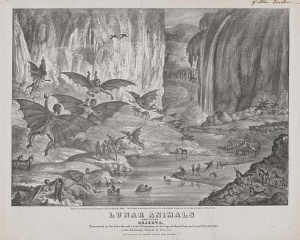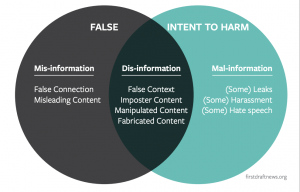Difference between revisions of "Misinformation"
m |
|||
| Line 1: | Line 1: | ||
| − | |||
[[File:terms.png|thumbnail|right|Venn diagram comparing misinformation, disinformation, and mal-information]] | [[File:terms.png|thumbnail|right|Venn diagram comparing misinformation, disinformation, and mal-information]] | ||
| Line 26: | Line 25: | ||
==See also== | ==See also== | ||
| + | *[[Fake News]] | ||
*[[Parody]] | *[[Parody]] | ||
*[[Social Networking]] | *[[Social Networking]] | ||
Revision as of 16:59, 15 March 2019
Misinformation is unintentionally inaccurate or misleading information.[1] Information that is reported in error, rumors, and pranks are all examples of misinformation. Satire and parody as forms of social commentary can result in misinformation if the content is considered to be serious and thus spread with the belief that the information is true. Misinformation is not to be confused with disinformation, which is intentionally inaccurate or misleading information. The terms “misinformation” and “disinformation” differ in regards to the intent behind the information diffusion. Both terms, along with “propaganda”, have been studied in association with social media in order to determine their societal impacts, as well as for misinformation correction efforts.
Contents
Origins
The earliest known uses of misinformation, disinformation, and propaganda have been dated back to ancient Rome.[2] These overlapping terms and their history are related to that of mass communication and information technology (IT), which is a term that also encompasses information distribution technologies such as television.

The invention of the Gutenberg printing press in 1483 acted as an agent of change that escalated the ability for the mass spread of information, misinformation, and disinformation.
A noteworthy instance of the dissemination of misinformation occurred in August of 1885, in which The New York Sun published a series of 6 articles describing life on the moon. The articles included illustrations of unicorns and flying humans with bat wings. This occurrence became known as “The Great Moon Hoax” of 1835.
See also
References
- ↑ Jack, C. (2017). Lexicon of lies: Terms for problematic information. Data & Society, 3. Retrieved from https://apo.org.au/sites/default/files/resource-files/2017/08/apo-nid183786-1180516.pdf
- ↑ Posetti, J., & Matthews, A. (2018). A short guide to the history of ’fake news’ and disinformation. International Center for Journalists, https://www. icfj. org/sites/default/files/2018-07/A% 20Short, 20.
- ↑ Day, B. H. (1835). Lunar animals and other objects Discovered by Sir John Herschel in his observatory at the Cape of Good Hope and copied from sketches in the Edinburgh Journal of Science., 1835. [Photograph] Retrieved from the Library of Congress, https://www.loc.gov/item/2003665049/.
